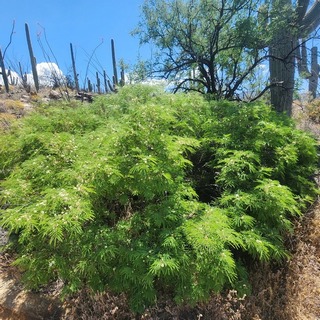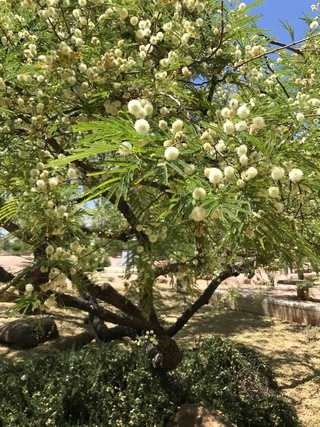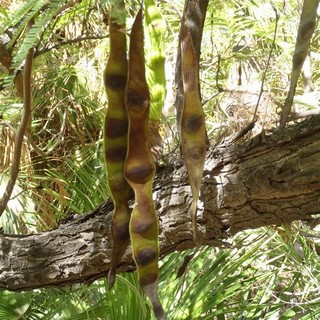Featherbush is a lacy tree that is lovely and provides dappled shade all year. But with its lime green foliage and delightful puff ball flowers, it really stands out in the spring. Here’s everything you need to know about growing this graceful Sonoran Desert native in this complete care guide.

Featherbush (Lysiloma watsonii) naturally grows as a large feathery shrub in its native habitats of southern Arizona and Mexico. But when used in the landscape, it’s usually grown as a small, graceful ornamental tree.
Its leaves are lacy and fern-like, providing welcoming dappled shade. In the spring, this plant is a knock-out. Its new leaves are bright spring green, a color rarely seen in the desert.
You can see how this young featherbush pops compared to the surrounding desert plants.

April through June, plants are festooned with creamy-white puff ball flowers. Flowers are followed by large bean-like pods.
This tree may look lacy and delicate, but it’s a tough desert plant that is tolerant of desert heat, sun, and aridity. It is “nearly evergreen” here in Tucson, loosing leaves only after extreme cold.
This is an excellent plant for supporting wildlife. Birds enjoy the seeds and use it for shelter. It’s a larval host plant for several species of butterflies. When in bloom, its flowers attract bees and butterflies.
Why I Like This Plant
- Lacey, graceful, small tree
- Vivid green foliage, puff-ball flowers in the spring
- Thornless
- Attracts birds, bees, butterflies
Things to Watch Out For
This plant is much easier to grow as a large shrub. If you plan to grow it as a small tree, be prepared to regularly remove the numerous suckers is produces.
Training it to grow as an attractive, multi-trunk tree is a job best left for professionals. Unless this is a skill you have mastered, I would urge you to hire an arborist to get it off to a good start.

A word of caution! Don’t even think about trying to grow one as a single-trunk “lollipop” tree. That will be an uphill battle, and neither you nor your tree will be happy.
And finally, seed pods are large (up to 6″) and plentiful. So expect to pick up pods during the summer.
Optimal Growing Conditions
If you’re thinking of adding a featherbush to your garden, you need to find a suitable place that will keep your plant healthy and looking good… while minimizing maintenance for you.
Here are the key factors to keep in mind.
Temperature
Featherbush should be grown in USDA Hardiness Zones 9 – 10. As a Sonoran Desert native, it’s tolerates desert heat. It’s considered cold-hardy down to 20℉ but suffers cold damage below 25℉.
It’s semi-deciduous — it stays evergreen in frost-free areas, but normally it loses its leaves for a short time before new spring growth appears. Here in Tucson, it’s nearly evergreen, loosing leaves only after subfreezing temperatures.
Sun Exposure
Featherbush thrives in full sun but tolerates partial shade.
Size and Growth Rate
Featherbush grows moderately fast and reaches a size of 15 feet tall and wide. If you grow it as a shrub rather than a tree, you can keep it smaller by pruning.
It’s growth rate and size depends somewhat on how much water it receives.
Soil
In its native habitat, featherbush grows in rocky, alkaline soil, but it will grow in any type of desert soil, provided it’s well-draining.
Other Location Considerations
Feathertree makes a nice patio tree for small spaces.
It is a good substitute for mesquites, since it’s smaller and does not have thorns. However, like mesquites, it produces copious numbers of pods, so don’t plant them near a pool or other area where you don’t want the mess.

Featherbush:
The Essentials
| Common Name | Featherbush |
| Scientific Name | Lysiloma watsonii |
| Origin | Arizona, Mexico |
| Plant Type | Semi-deciduous Shrub, tree |
| USDA Zones | Zones 9 – 10 |
| Cold Hardy | To 20℉ |
| Flower Color | Yellow |
| Flower Season | Spring |
| Mature Size | 15-20’ tall & wide |
| Growth Rate | Moderate |
| Sun Tolerance | Full, part sun |
| Water Needs | Low |
| Pests & Diseases | None |
| Garden Friendly | No thorns |
| Wildlife | Attracts birds, bees, butterflies |
How to Plant
The rule of thumb when planting any tree or shrub in the desert is to dig a hole three times as wide as the root ball but no deeper. Amending the soil is not recommended. Counterintuitively, backfilling with the same native soil you just dug up helps your plant develop a stronger root system.
When to Plant
The best time to plant featherbush is in the fall. This gives your plant three seasons to grow roots and get established before the following summer.
The second best time is in spring, the earlier the better. This still gives your plant time to get established before the intense heat of June arrives.
How to Care for Featherbush
Whether you’ve recently planted a new featherbush or have an existing one in your yard, here’s how to take care of it to keep it healthy and looking its best.
How to Water New Plants
Once you’ve got your tree in the ground, watering is your most immediate concern. Here is the recommended watering schedule for new trees planted in the spring or fall.
| Weeks 1 & 2 | Every 3 – 4 days |
| Weeks 3 & 4 | Every 6 – 7 days |
| Weeks 5 & 6 | Every 7 – 10 days |
| Weeks 7 & 8 | Every 10 – 14 days |
After week 8, gradually extend the time between waterings.
How to Water Established Plants
As your tree becomes established, there are two watering factors to consider.
- First is how often to water. This will vary with the seasons.
- Second is how much water to give your tree with each watering. This depends on the current size of your tree.
To determine the ideal watering schedule for any desert tree, you’ll find everything you need to know, including easy-to-use charts, at How to Water Desert Trees: How Often? How Much?
Should You Fertilize?
As a desert native, this plant gets all the nutrients it needs from native soil. And since featherbush is a member of the legume family (Fabaceae), plants fix nitrogen which naturally improves their surrounding soil.
How to Prune
If you let your featherbush grow as a shrub, it won’t need much pruning. In the spring, remove any branches that were frost-damaged. After it’s done blooming, you can further prune to shape or control size.
But if you want to grow it as a small multi-trunk tree, it will need a few years of training to get the shape you’re looking for. If you go this route, I strongly urge you hire an arborist. If not pruned correctly from the start, you can ruin its shape forever.
You can prune the inevitably suckers anytime of year. I recommend pinching them off with your fingers as soon as they appear. This will result in fewer scars on the trunk.
For Plant Lovers
Featherbush goes by several other common names (and spellings) including feather bush, feather tree, fern of the desert, desert fern, fern tree, and littleleaf false tamarind.
It’s a riparian shrub that naturally grows along washes. It mainly occurs in Sonoran, Mexico, but also grows in a very specific location in Arizona — on the south side of Tucson’s Rincon Mountains.
Did you enjoy this article?
Sign up for our weekly newsletter
where you’ll find more great info on creating &
maintaining a beautiful, carefree desert landscape.
Author Bio
Deane Alban is the creator of Southwest Gardener. She is a science writer with a bachelor’s degree in botany from the University of South Florida. Gardening is her lifelong passion. She’s been gardening in Tucson for over 15 years.

Photo Credits
Della Killeen, CC BY-SA 4.0, iNaturalist.com
The University of Arizona Campus Arboretum
Dan Beckman, CC BY-SA 4.0, iNaturalist.com
